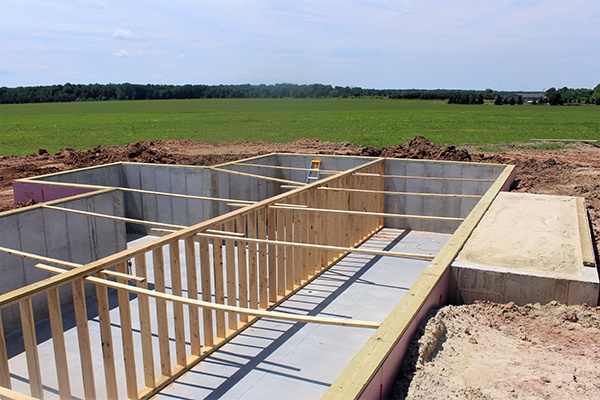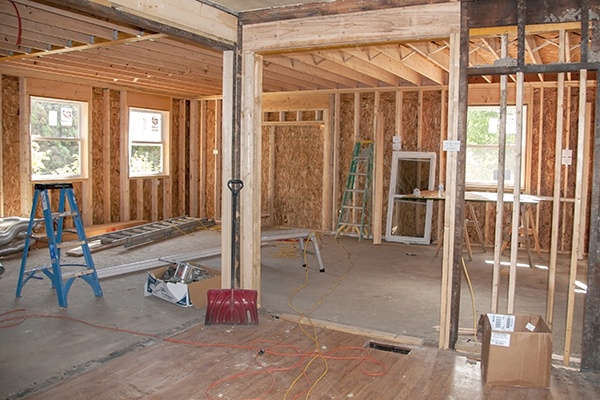Most likely, if this is the first vacant lot you’ve purchased, this is the first house you will build. While this can be both an exciting and promising experience, it can also get quite confusing and overwhelming quickly without a proper plan. So, here are just a few of the first steps you’ll take after the purchase of a new lot of land:
Surveying
Using wooden stakes, surveyors stake the corners and the lot lines of the lot and your desired position of the home on the building site. This process is referred to as “staking the lot." Surveying and staking are important functions, as homes have been found in violation of certain regulations or restrictions, and if a surveyor improperly surveys your land, they are responsible for the expenses associated with correcting the mistakes.
If there are existing stakes marking the corners and property lines of a building site, it is recommended that the lot be re-staked anyway as the stakes for the lot could have been moved or torn down before or since you purchased it. A surveyor will know how to locate and correct this issue and prevent what could turn into an extremely costly error.
Clearing and Excavation
Clearing a building site includes clearing trees, brush, rocks, and roots from where the home will sit, and usually an additional 10 feet or more around where the foundation will be - allowing space for heavy equipment needed at the building site.
Utilities Hookup
Your realtor or purchasing agent should have given you the information regarding cost and availability of utilities at the time your lot was purchased. You’ll need to make plans for each utility (phone, cable, water, electricity) to be paid for and installed before building, so that subcontractors can use at least the water and electricity for the building.
Footings
Footings are the base of a structure. They are made up of a mass of concrete that supports the foundation of the house and can be poured into trenches or wooden forms. Footings are probably the most important part of a new home building process. If footings move or settle, so will your home. If they are done improperly and not according to the dimensions of your building plans, the plans will need to be changed to accommodate the footings or be done over.
The locations of footings are checked by building inspectors before being poured to be sure they are deep enough and that they rest on undisturbed earth. This inspection is highly necessary and will help you avoid spending thousands of extra dollars in the future if there is a problem.
Foundations
Foundation material can be concrete block, brick or poured concrete. Stone foundations are no longer used because they aren’t as strong as concrete or brick. Stone is better used for aesthetic purposes - as a veneer like brick.
After the foundation is in and before the concrete is poured, it is wise to have your soil treated for pests or insects - termites in particular.
Rough-in-Plumbing
If your house is being built on a concrete slab (instead of wooden floor joists), once your foundation is in, backfilled, tamped (packed down), and your soil treated, your plumber will install your sewer lines and water pipes that will stay under the concrete. Also, any electrical wiring that goes under the concrete is placed in a conduit and roughed-in.
…..these are the first six basic steps that go into the building of every home. Stay tuned for the next blog which will cover the next steps that go into building your home from day one.
 As we start a brand new decade, we noticed a change happening all around us. Things are shocking up a bit when it comes to home design trends.
As we start a brand new decade, we noticed a change happening all around us. Things are shocking up a bit when it comes to home design trends.  Decorating your home can be fun and exhausting all in one. Decorating trends are constantly changing from year to year, and it is hard to keep up. If you love color trends, then you will want to know what the new color of the year is.
Decorating your home can be fun and exhausting all in one. Decorating trends are constantly changing from year to year, and it is hard to keep up. If you love color trends, then you will want to know what the new color of the year is. Basements are a great way to add cheap square footage to a home. It is a whole other house, under your house, that can be used for anything. Sure, you might have enjoyed the extra room from a basement up north, but when you come down to Florida, something is missing. There aren't many basements in Florida, and there is a solid reason for it
Basements are a great way to add cheap square footage to a home. It is a whole other house, under your house, that can be used for anything. Sure, you might have enjoyed the extra room from a basement up north, but when you come down to Florida, something is missing. There aren't many basements in Florida, and there is a solid reason for it Solar power is a big topic for many people concerned with their carbon footprint and use (or misuse) of energy in their homes. Some people have opted to have solar panels installed in their homes to combat the energy crisis and virtually eliminate their power bill every month. A popular spot for these solar panels is on the rooftops of houses. So what exactly are solar-powered roofs, and what does one get from having them installed?
Solar power is a big topic for many people concerned with their carbon footprint and use (or misuse) of energy in their homes. Some people have opted to have solar panels installed in their homes to combat the energy crisis and virtually eliminate their power bill every month. A popular spot for these solar panels is on the rooftops of houses. So what exactly are solar-powered roofs, and what does one get from having them installed? We are five months into the new year, and there are already many lists for the "Best Of ____ in 2019". This one is going to be no different besides the fact that it might be beneficial to you! Have you recently moved into a new place or purchased a new home? Is everything up to modern standards? How would you like to make your home life just a little bit easier? Maybe now is the time for you to upgrade your new home with some new smart home devices! But with so many gadgets to choose from, how do you know which ones are the best? Look no further because here you will find the top 3 smart home devices for your new home in 2019!
We are five months into the new year, and there are already many lists for the "Best Of ____ in 2019". This one is going to be no different besides the fact that it might be beneficial to you! Have you recently moved into a new place or purchased a new home? Is everything up to modern standards? How would you like to make your home life just a little bit easier? Maybe now is the time for you to upgrade your new home with some new smart home devices! But with so many gadgets to choose from, how do you know which ones are the best? Look no further because here you will find the top 3 smart home devices for your new home in 2019! Part of what makes Florida so popular is all the different things to do and experience here. A lot of what goes into that is the people that help bring it from an idea to a physical building or structure, turning someone's dreams into a reality. To make those dreams happen, the use of a general contractor is more than likely going to be needed in some way, shape, or form. So what exactly is a Florida general contractor and what do they do? Find the answer to that and a few other inquiries of what it takes to be a general contractor in the Sunshine State.
Part of what makes Florida so popular is all the different things to do and experience here. A lot of what goes into that is the people that help bring it from an idea to a physical building or structure, turning someone's dreams into a reality. To make those dreams happen, the use of a general contractor is more than likely going to be needed in some way, shape, or form. So what exactly is a Florida general contractor and what do they do? Find the answer to that and a few other inquiries of what it takes to be a general contractor in the Sunshine State. It's best to be prepared and know what you want when you start, rather than to pick up pieces along the way. Building a new home can raise a lot of questions too, and it's important to figure out the essentials right away. When it comes to building a house in Florida, what are some of the most pressing questions you should have before breaking ground? Here we will go over the top 3 things you should ask before putting those blueprints into reality.
It's best to be prepared and know what you want when you start, rather than to pick up pieces along the way. Building a new home can raise a lot of questions too, and it's important to figure out the essentials right away. When it comes to building a house in Florida, what are some of the most pressing questions you should have before breaking ground? Here we will go over the top 3 things you should ask before putting those blueprints into reality. An expansion is on the top of that list. Maybe your family is growing, perhaps you just don't have enough room for all your stuff, or maybe you want to expand into a back or front porch. Rather than look for a new place to live, why not just add on to what you already have?
An expansion is on the top of that list. Maybe your family is growing, perhaps you just don't have enough room for all your stuff, or maybe you want to expand into a back or front porch. Rather than look for a new place to live, why not just add on to what you already have?

